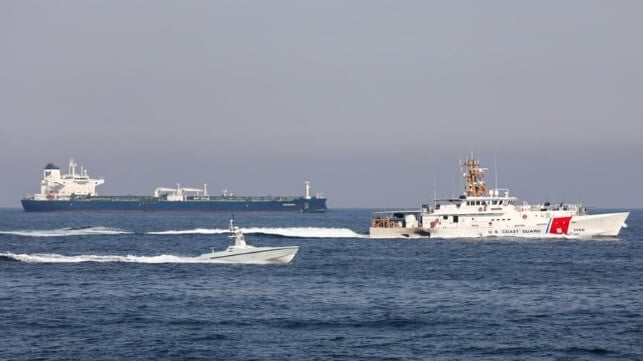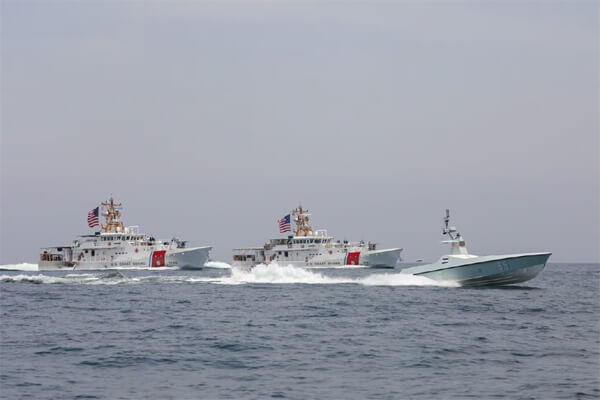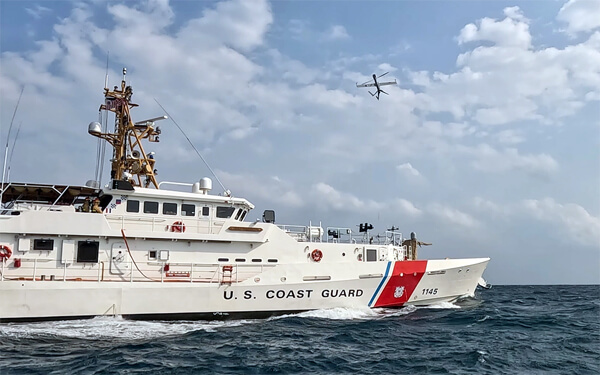U.S. Navy Sends First Unmanned Vessel Through Strait of Hormuz

The U.S. Navy sent its first unmanned surface vessel through the busy Strait of Hormuz on Wednesday, April 19, as part of its ongoing efforts to integrate drones into the fleet for a broad range of patrols and monitoring. The 41-foot vessel that looks like a speed boat was escorted by two U.S. Coast Guard cutters and according to reports was closely observed by the Iranians.
The vessel used for the transit was one of the Navy’s L3 Harris Arabian Fox Mast-13 unmanned surface vessels deployed to the region as part of Task Force 59, a specialized unit for unmanned systems and artificial intelligence. The Navy has been using the MAST-13 on a range of missions in the region including several of its international exercises. The craft carries an array of cameras and sensors.
The MAST-13 was accompanied by two of the U.S. Coast Guard Fast Cutters, the USCG Charles Moulthrope and USCG John Scheuerman that are among the vessels patrolling the region in support of the International Maritime Security Construct, an 11-nation coalition led by the United States that focuses on maritime operations near key waterways in the Middle East. They reported that the three vessels sailed south from the Arabian Gulf and the through the narrow Strait of Hormuz before entering the Gulf of Oman. The vessel successfully navigated the strait, which at its narrowest point is just 20 miles between Oman and Iran, and managed with the traffic in the strait during the voyage.

The 41-foot vessel navigated the busy Strait of Hormuz entering the Gulf of Oman (US Navy photos)
Iranian forces according to a report by the Associated Press were seen closely observing the transit but did not approach the drone unlike last year when they approached and on one occasion seized a U.S. Navy Saildrone also operating in the region. Iran’s Mehr news agency later acknowledged the trains under the headline “US Navy allegedly sails first drone through Strait of Hormuz.”
“We are on the cutting edge of integrating advanced unmanned technology into our maritime patrols. Our crews are excited to help lead these efforts with our Navy counterparts,” said Lt. Stephen Hills, commanding officer of USCG Charles Moulthrope after the transit.
The U.S. Navy’s 5th Fleet established a unit called Task Force 59 in September 2021 to integrate unmanned systems and artificial intelligence into regional maritime operations. Task Force 59 is focusing on how to best leverage the unmanned and AI systems, expanding the monitoring efforts to better utilize naval forces in the region.
In addition to the deployment of the MAST-134 and Saildrones, in December, Task Force 59 launched an Aerovel Flexrotor unmanned aerial vehicle from USCGC Emlen Tunnell while operating in the Arabian Gulf. The launch marked Task Force 59’s first from a U.S. Coast Guard vessel.

Task Force 59 deployed an Aerovel Flexrotor for the first time from a USCG vessel in December 2022 (US Navy photos)

that matters most
Get the latest maritime news delivered to your inbox daily.
Speaking about the program, Vice Adm. Brad Cooper, commander of U.S. Naval Forces Central Command and commander of the 5th Fleet, recently said the harsh and inhospitable waterways of the Middle East offer ideal conditions to test and mature unmanned surface vessels that can be integrated into naval operations. According to the Navy, the integration of unmanned platforms and sensors alongside crewed ships from the United States and regional partners enhances its capability. Since its launch, the task force has deployed a suite of new unmanned systems from operational hubs in Jordan and Bahrain, and by mid-year, they expect to have 100 systems deployed.
The U.S. 5th Fleet leads regional efforts to increase vigilance in the region that includes more than 5,000 miles of coastline from the Suez Canal, around the Arabian Peninsula, through the Strait of Hormuz, and into the Arabian Gulf.
